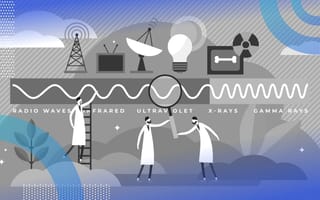The word “radar” most often brings to mind weather forecasts, military operation surveillance, and air traffic control. However, recent developments in ultra-wide-band, or UWB radar, point to much untapped potential for novel applications, most specifically in the healthcare and building technology spaces.
Put simply, UWB radar systems send signals across a wider frequency than standard radar signal systems by transmitting pulses with extremely short durations. This radar can then be used to track the micro vibrations generated by the human respiratory and circulatory systems, giving continuous and autonomous readings of resting heart rate and respiratory rate of the occupants in a space without wearables, cameras, or human handling of any equipment. Furthermore, UWB radar devices generate less radiation than the typical home WiFi router, therefore offering completely safe use.
What’s so unique about the UWB radar space is that recent technological advancements have opened up a myriad of potential use cases that have far reaching possibilities in healthcare, business management, energy-efficiency, and more.
What Is Ultra-Wide-Band (UWB) Radar? How Does It Work?
Two Use Cases for UWB Radar: Healthcare and Energy Efficiency
Healthcare Applications
The average annual cost of professional home care in the U.S. is more than $50,000, and unpaid family caregivers spend a reported $7,000 to $12,000 a year on their patients out-of-pocket. Looking at healthcare just through the lens of Covid-19 patients, research is suggesting that many will need long-term care and recovery monitoring due to permanent lung damage, underscoring a greater need for efficient and continuous monitoring that isn’t cumbersome to the patient. Still, beyond Covid, the ability to monitor both vital signs and movement has implications in the home care of chronic respiratory disease, cardiovascular disease, Alzheimer’s and dementia patients, and general senior care. Using UWB radar to autonomously and continuously monitor vital signs allows caregivers the opportunity to focus on proactive prevention, rather than reactive intervention, greatly reducing these dramatic costs while improving the level of care.
The use of UWB radars can also be transformative in hospitals. Routine checking of vitals, which depends upon staffing and schedules and is susceptible to human error, can be replaced by continuous, autonomous radar monitoring. In an era of overcrowded hospitals and overworked staff, this type of technology could alleviate serious challenges hospitals currently face, allowing them to provide high-quality care with a lower budget and less pressure on staff. It is a win-win situation, with care for patients being improved while also improving the working environment for hospital nurses, doctors, and staff.
The consistency of UWB radar for vital signs is similarly critical to early deterioration detection. Most critical respiratory and/or cardiovascular events are preceded by warning signs six to eight hours in advance. Continuous tracking of respiratory and heart rates allows for more effective monitoring, allowing for proactive prevention of an event before it happens, rather than taking drastic and expensive health measures in order to stop an event once it is already occurring. Current means of monitoring often don’t take into account other body systems that may be stressed. For example, in the case of current pulse oximeters, healthcare professionals are only monitoring the output. What isn’t able to be monitored is how much harder the heart is working (due to a number of potential factors) in order to keep the oxygen in the blood at acceptable levels. By measuring the micro-movements continuously, healthcare staff will have much more actionable data that can present a much more holistic view of a patient’s vital signals with more context than ever before.
Energy Efficiency and Security
Cameras and motion sensors inevitably make mistakes in terms of people-counting and presence detection. For example, an occupant may be outside the camera’s range of vision, or a person sitting still for too long may be completely overlooked by a motion sensor. By using radar, presence is detected through heartbeat and breathing, giving 99.99 percent accurate results for presence detection — after all, a heartbeat can’t hide. Buildings such as hotels, office buildings, and even hospitals that currently use motion sensors for lighting, cooling, and computer electricity waste $200 billion annually, according to Energy Star. This is because these monitors utilize a 15-45 minute cycle for vacancy detection, whereas UWB radar has the ability to detect vacancy within one minute. HVACs and lighting systems that cannot effectively detect presence cause businesses to waste billions on lighting, heating, and cooling a space that is empty. The accuracy provided by UWB radar has the potential to save these companies thousands of dollars and save the planet by saving resources.
Furthermore, because the use of UWB radar eliminates the need to use cameras, microphones, or smartphone data, there is no risk of data leaks or privacy interference. In a time of heightened tensions around privacy and data security, UWB presents a groundbreaking solution for businesses and the commercial real estate sector when it comes to managing their spaces without invading the privacy of tenants, employees, or patients.





